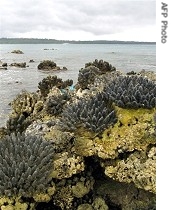2007年VOA标准英语-Researchers Find Large-Scale Death of Coral in
搜索关注在线英语听力室公众号:tingroom,领取免费英语资料大礼包。
(单词翻译)
By Chad Bouchard
Jakarta
23 April 2007
Scientists have discovered that an earthquake two years ago in Indonesia lifted hundreds of kilometers of sea floor out of the water, causing the largest death of coral reefs ever recorded. As Chad Bouchard reports from Jakarta, this is only one of several threats facing Indonesia's fragile marine2 ecosystems3.
| Researcher examines uplifted coral on west coast of Simeulue, Indonesia (file Mar 2007) |
Andrew Baird is a scientist with the Australian Research Council Center of Excellence5 for Coral Reef Studies. He says the effects of the earthquake were totally unexpected.
"I thought I was ready for what we saw, but the scale of the uplift was quite incredible," he said. "You know every day, every site we went to, there was more reef which had been completely thrust out of the water. The entire perimeter6 of an island - about 400 kilometers of reef - had been thrust out of the water, literally7 overnight."
The 2005 temblor also killed nearly 1,000 people on the nearby island of Nias. It struck just three months after Indian Ocean tsunami8, which hit the day after Christmas 2004 and left 230,000 people dead or missing from Indonesia to eastern Africa.
Massive die-offs caused by earthquakes like the one that hit Simeulue happen about once a century, and Baird says researchers are just beginning to understand earthquakes' effects on marine environments.
But there are also other threats bearing down on Indonesia's coral reefs, which amount to 17 percent of the world's total. The reefs measure about 51,000 square kilometers - enough to cover the islands of Hawaii more than three times. They provide critical breeding and nursery habitat for much of the region's marine species.
Stuart Campbell is coordinator9 of the Indonesia Marine Program of the U.S.-based Wildlife Conservation Society, which also took part in the Simeulue survey.
Campbell says the exposed coral and evidence on nearby islands revealed a wide-scale infestation10 of Crown of Thorns starfish.
The same starfish have decimated parts of Australia's Great Barrier Reef. Campbell says scientists think human factors such as river pollution and runoff due to deforestation are responsible for the starfishes' spread.
"What they've shown in the Great Barrier Reef is that they think that plumes11, sort of dirty water essentially12, is contributing to their (the starfishes') dispersal, and maybe because they're better able to reproduce in poor-quality water, and then once they reproduce, they can just island-hop essentially, with the currents," he said.
Researchers say 82 percent of the country's coral is also at risk from pollution and destructive fishing practices, such as underwater explosions and the use of cyanide to stun13 live fish and seafood14.
"We saw signs where people have previously15 bombed, used cyanide, and we also witnessed the Crown of Thorns starfish invasion. So it's a sort of a multiple-pronged attack on these reefs," he said.
The use of bombs and cyanide for fishing has been illegal in Indonesia for more than 20 years. But local authorities say they don't have the resources to protect the archipelago's sprawling16 marine habitats.
 |
| Uplifted coral on west coast of Simeulue (file Mar 2007) |
"The problem is petrol…the price of petrol has trebled in the wake of these natural disasters," he said. " It's $200 to do a loop of the islands, which doesn't sound much to us, but that's a month's wages for these guys."
But Riza Damanik of the Indonesian environmental group WALHI says money for the police is not the problem.
"The problem is not the quantity of the police, or the boats. Our government can do (anything) if they want. It's just like political will from them," he said.
Damanik says the assault on coral reefs is damaging the country's capacity to produce fish, even as an increasing population drives up the domestic demand for fish. Government statistics indicate Indonesia takes out 200,000 more tons of fish than its waters can replenish17 each year.
Riza is calling for Indonesia to create a special department to focus more on protecting its marine resources.
"Too many things pushed by the government. Mining and forestry18 and blah blah blah. But they forget we are an archipelago state. But our future is in the sea. Our life is in the sea," Riza said.
Members of the survey team say in spite of the damage they have documented at Simeulue, reef species are already returning. Since the earthquake two years ago, new corals have attached to remaining underwater reef and have grown to a few centimeters wide.
Scientists say the evidence indicates that if the police and conservationists can stop the recurrent threats, the reefs will recover.
 收听单词发音
收听单词发音 




